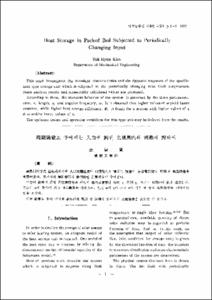경남지방 씨족마을의 입지특성과 내부배치에 관한 연구
- Alternative Title
- Locational Characteristics and Internal Layouts of Traditional Villages of Kyongsang-Namdo Area Formed in Chosun Dynasty
- Abstract
- 본 연구는 조선시대에 형성된 경상남도내 22개 마을을 택하여 그들의 특성과 내부배치를 밝혀 보고자 하는 것이다.
분석된 결과들은 다음과 같다.
(1) 마을들은 고을의 관아로부터 이십오리 정도 떨어져 있어서 수령의 간섭을 덜 받고 씨족의 공동체를 구성하기에 유리하다.
(2) 마을들의 지형적 입지를 볼 때 크게 산지, 평야, 해안으로 나눌 수 있으며 산지에 위치하는 경우가 전체의 54.5%로 우세하다.
(3) 마을에 진입하는 방법은 통과형, 관통형, 종점형의 3유형이 있으며 이중 통과형이 14개 마을(전체의 63.6%)로 다수이다.
(4) 마을길의 형태는 나뭇가지형(12개소:54.5%), 그물형(6개소:27.3%), 복합형(4개소:18.2%)으로 나누어진다.
(5) 주택의 향은 남동∼남서향이 전체의 82.5%로 나타난다.
(6) 마을에는 대부분 종가와 재실이 존재하고 일부 마을에서는 당산나무와 경승지가 있다.
결론적으로, 경남지방의 전통마을들은 산지와 평야에 적절히 입지하고, 그 내부배치는 유교문화를 충실하게 반영하며 유기적인 구성을 이루고 있다고 할 수 있다.
This study aims at analyzing the locational characteristics and internal layouts of 22 traditional villages of Kyongsang-Namdo area formed in Chosun Dynasty.
Analyzed results are as follows:
(1) Villages are ditanced from the local administrative offices, which discourages the influence of officials and encourages the self-governance of clan members.
(2) Villages are located mainly in mountainous area(valley and mountain slope), flat field and sea coast. The numbers of villages located in mountainous area are the largest(12:54.5%).
(3) The types of access roads are passing type, penetrating type and terminus type. Of 3, passing type is the largest in numbers(14:63.6%).
(4) The types of road networks are tree type, network type and complex type. Of 3, tree type is the largest in numbers(12:54.5%)
(5) The main orientations of most houses(82.5%) are South-East, South and South-West.
(6) In every village there are 1 Chongga(house of the family hierachically highest) and 1 or 2 Chaesil(communal building used by all clan members). And in several villages there are sacred trees and scenic objects such as trees, rocks and cliffs.
In conclusion, traditional villages of Chosun Dynasty are located at proper sites and their internal layouts of building and roads reflect the Confucius culture and are integrated organically.
This study aims at analyzing the locational characteristics and internal layouts of 22 traditional villages of Kyongsang-Namdo area formed in Chosun Dynasty.
Analyzed results are as follows:
(1) Villages are ditanced from the local administrative offices, which discourages the influence of officials and encourages the self-governance of clan members.
(2) Villages are located mainly in mountainous area(valley and mountain slope), flat field and sea coast. The numbers of villages located in mountainous area are the largest(12:54.5%).
(3) The types of access roads are passing type, penetrating type and terminus type. Of 3, passing type is the largest in numbers(14:63.6%).
(4) The types of road networks are tree type, network type and complex type. Of 3, tree type is the largest in numbers(12:54.5%)
(5) The main orientations of most houses(82.5%) are South-East, South and South-West.
(6) In every village there are 1 Chongga(house of the family hierachically highest) and 1 or 2 Chaesil(communal building used by all clan members). And in several villages there are sacred trees and scenic objects such as trees, rocks and cliffs.
In conclusion, traditional villages of Chosun Dynasty are located at proper sites and their internal layouts of building and roads reflect the Confucius culture and are integrated organically.
- Issued Date
- 1997
- Type
- Research Laboratory
- Alternative Author(s)
- Lee,Kyu-Sung
- Publisher
- 공학연구논문집
- Language
- kor
- Rights
- 울산대학교 저작물은 저작권에 의해 보호받습니다.
- Citation Volume
- 28
- Citation Number
- 2
- Citation Start Page
- 1
- Citation End Page
- 19
- Appears in Collections:
- Research Laboratory > Engineering Research
- 파일 목록
-
-
Download
 000002025362.pdf
기타 데이터 / 195.17 kB / Adobe PDF
000002025362.pdf
기타 데이터 / 195.17 kB / Adobe PDF
-
Items in Repository are protected by copyright, with all rights reserved, unless otherwise indicated.